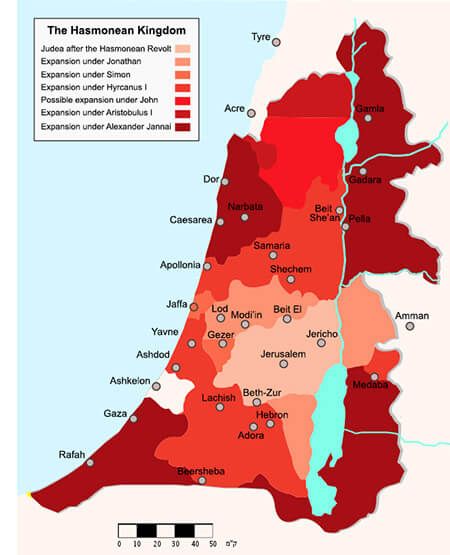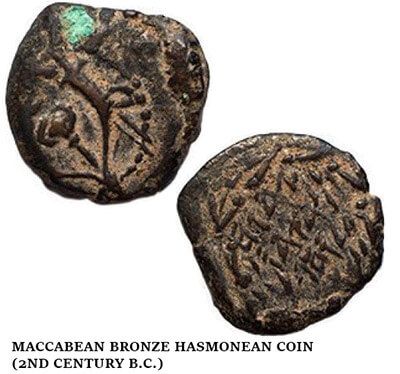Bronze Jewish Ancient Hasmonean Coin

Bronze Hasmonean Coins
Although the Hasmoneans continued to use silver Seleucid coins for the larger denominations, the Hasmoneans began to mint small bronze coins with the name of each ruler.
The names that can be found on these coins are Yochanan – John Hyrcanus I (103-105 B.C) and John Hyrcanus II (63-40 B.C.) Yehonatan – Alexander Jannaeus (103-76 B.C.) Yehudah – Judah Aristobulus (104-103 B.C.) Mathias – Matthias Antigonus (40-37 B.C.)
The bronze Hasmonean coins have a variety of symbols, including the double cornucopia (found on the modern NIS 2 Shekel coin), the lily (found on the NIS 1 Shekel coin), the star, and the palm branch.
The most fascinating aspect of these coins, however, are their inscriptions. The inscription on these coins (except the star design Alexander Jannaeus) reads, “name of the ruler, high priest, and council of the Jews” in an ancient paleo-Hebrew script.

The paleo-Hebrew script on these coins was the common script during the Israelite monarchy (during the days of King David and Solomon), however, after around the fifth century B.C., we see the square Aramaic script (what is used in the Masoretic text of the Old Testament) replace the old paleo-Hebrew script.
These coins were minted 300 years after it was believed that this paleo-Hebrew script had been extinct. Why is this?
There is much debate on why this script is used. One belief is that the Hasmoneans used this style of script in order to make a political statement that they were restoring the old Davidic dynasty. Another belief is that this older script was used to enhance the value and tradition of these coins, much in the same way that the U.S. dollar uses Latin.
A third belief is that the script was still in use, and was well known during the second century B.C., even though we have very few preserved texts from this period in paleo-Hebrew. One exception is that many of the Dead Sea Scrolls use paleo-Hebrew for the name of God.
This demonstrates the belief of that same period that the current Aramaic script was not pure enough to write the name of God, and the old paleo-Hebrew was used to preserve the holiness of God’s name. This indicates that this script was known to the minters, and probably also to the everyday people of this time, by using this script, the Hasmonean rulers are recreating and restoring an ancient dynasty in Israel.
Although there are some mistakes on the coins, and almost no two coins are alike with so many textual variations, the name of the ruler is always correct, and usually only the vowels are left out in abbreviation because of the small size of these coins.
It seems that the minters were very familiar with this ancient script, and the errors are simply the result of a long text on a very small space. Zak Mishriky Old city Jerusalem gifts Jerusalem



Leave a Reply
You must be logged in to post a comment.